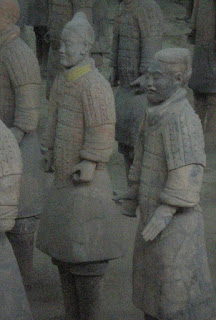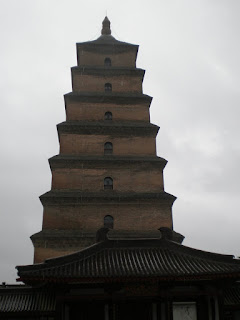The drive through the rain took about an hour, and we made small talk along the way. Once we arrived we were handed three umbrellas from the driver, thank goodness he had them because at this point it was essentially a torrential downpour. Kellie led us onward and purchased the tickets we needed. We were instructed of the order of events for the day; first we would eat lunch, then we would see pit number three, then two then one. We had actually requested this order because we were all so hungry and we were instructed that going from the smallest pit to the largest would be the most impressive way to see the warriors.
Our lunch was the typical Chinese lunch buffet, complete with noodles, soup, rice, chicken with vegetables, dumplings, cucumbers, and a few other select items. We found the food to be tasty, but at that point I think we would have eaten just about anything in front of us. We managed to stuff ourselves and decided we were ready to begin exploring the Terra Cotta Warriors. Kellie led us to Pit # 3, the smallest of the pits.

The building was wide open and we stood above the excavated pits peering down upon the ancient warriors. The lights were dimmed giving the terra cotta a distinct golden hue. Some of them were in tact after repair and others were in pieces lying in the dirt and rubble. They were still so life-like, seemingly alert and ready to defend the tomb. Some of them looked like fallen soldiers, leaning to one side or another.

We learned that the emperor’s of China were buried with their soldiers when they died. Sometimes, the soldiers would be buried alive if the emperor died prior to the soldiers’ death. This was an act of protection for the emperor’s tomb. In the case of the Terra Cotta Warriors, the Emperor used a combination of living soldiers and terra cotta constructed warriors. We continued on to Pit # 2, which was a bit larger and contained a few different figures, along with Terra Cotta horses.

Pit # 1 however was the most impressive of them all. The warriors had been excavated in pieces and put back together, fully intact, and placed in their original positions. It looked like a little army gathering to march forward and serve and protect. Parts of Pit #2 and Pit # 1 were still being excavated and preserved, and there were additional pits that were not open to the public. We left the warriors feeling satisfied with our trip. I think the consensus was that we were very happy to have visited.



We decided it would be best to head for the Wild Goose Pagoda, a Buddhist temple in Xian. The drive took about 20 minutes and after a long night on the train and a day of touring in the rain we all lounged and relaxed.

We arrived at the Wild Goose Pagoda after sitting in a bit of traffic. It was approximately 4:30 in the afternoon, and still raining. We walked to the entrance and continued on through the temple. Compared to a few of the temples I saw in Beijing, I was fairly unimpressed. This temple was much more modern than the others. But the detail and architecture was still very impressive, as were some of the jade carvings on the walls of the temples. We left the temple feeling satisfied and ready to put on dry socks, take a shower and attempt to do the unimaginable; buy tickets to Lhasa on the train.


Our tour dropped us off at Xian City Hotel, not the nicest accommodations in the world, but it served its purpose of a shower and a dry clean bed. We had a bedroom with two double beds, and a roll away bed and we paid 115 RMB each, approximately 15 dollars each for our room. We also had a package waiting for us at the hotel, which contained our Tibet Travel Permits.

Equipped with the permits in hand, we hopped into a cab and headed to the train station. The train station of course was crowded as usual. We found our place in line once again and were asked to show our passports and desired destination. The officer recorded all of this information by hand and we were directed towards the first line available. Everyone had told us that train tickets to Lhasa would ne nearly impossible to acquire in Xian. Because in China they only allow you to purchase tickets four days in advance it complicates things. It must have been our lucky day because within 15 minutes we left the station tickets in hand, headed for dinner. What a day it had been, and tomorrow signaled yet another adventure, a 36 hour train to Lhasa.


No comments:
Post a Comment